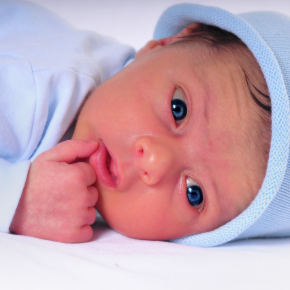
What lies behind a baby’s eyes
|
• Humans give meaning to their surroundings by assigning objects to categories; at what age does this process begin? |
We give meaning to our world through the categorisation of objects. When and how does this process begin? By studying the gaze of one hundred infants, scientists at the Institut des Sciences Cognitives Marc Jeannerod (CNRS/Université Claude Bernard Lyon 1) have demonstrated that, by the age of fourth months, babies can assign objects that they have never seen to the animate or inanimate category. These findings, published in PNAS on 15 February 2022, reveal measurable changes in neural organisation, which reflect the transition from simply viewing the world to understanding it.
The way babies look at the world is a great mystery. What do they really see? What information do they get from seeing? One might think they look at things that stand out the most—by virtue of size or colour, for example. But when do babies begin to see and interpret the world like adults?
To answer this question, researchers from the Institut des Sciences Cognitives Marc Jeannerod (CNRS / Université Claude Bernard Lyon 1) studied one hundred babies aged between 4 and 19 months. The scientists recorded the babies’ eye movements and the durations of their gaze as they looked at pairs of pictures representing animate or inanimate things from eight different categories (e.g., human faces and natural or artificial objects). The data obtained from eye tracking on babies were matched with measures of brain activity obtained from a group of adults using fMRI, in order to determine the correspondence between the categorical object organisation emerging from the babies’ eyes and that mapped on the adults’ visual cortex.
The methodology used in the study has revealed the transition from the visual exploration guided by the salience of objects, in the youngest babies, to an object representation towards the mature categorical organisation of the adult brain, in the older babies. Already at four months, babies can distinguish between animate and inanimate objects. For instance, they can tell that a man and a crocodile, being animals, are more similar to each other than they are to a tree, which is an inanimate object. This ability appears astonishing as, at that age, babies are unlikely to know what a tree or crocodile is.
Between 10 and 19 months of age, more refined categories emerge and the infants’ organisation of objects into categories increasingly approaches that in the adult brain. Children in this age range immediately recognise a soft, furry object with a face as a nonhuman animal.
This study1 shows that humans are born with a neural organisation predisposed to representing object categories crucial to their survival. Categorisation is the mechanism that enables us to go beyond what we see and make inferences, analogies, and predictions—for example, if that “soft, furry object” is a cat, it needs to be fed—and thus think about the world around us, from the earliest age.
- 1Funded by the European Research Council (THEMPO, 758473) and the Fyssen Foundation in Paris.
Visual object categorization in infancy. Céline Spriet, Etienne Abassi, Jean-Rémy Hochmann, Liuba Papeo. PNAS, 15 february 2022. https://doi.org/10.1073/pnas.2105866119


